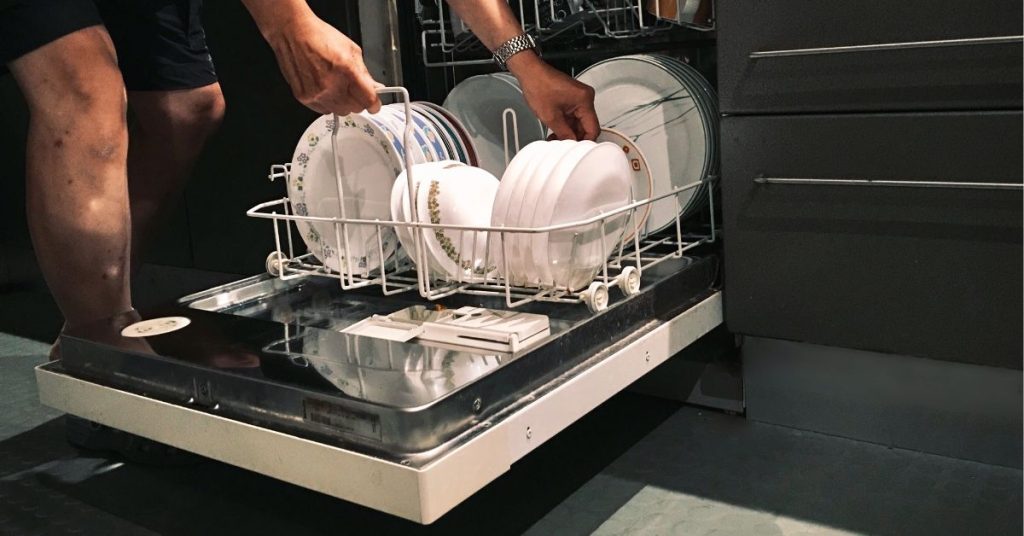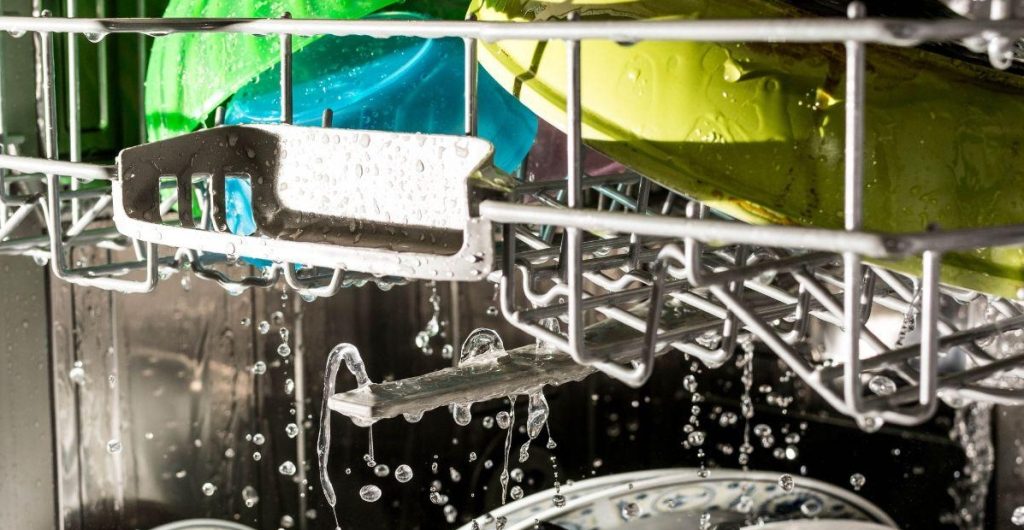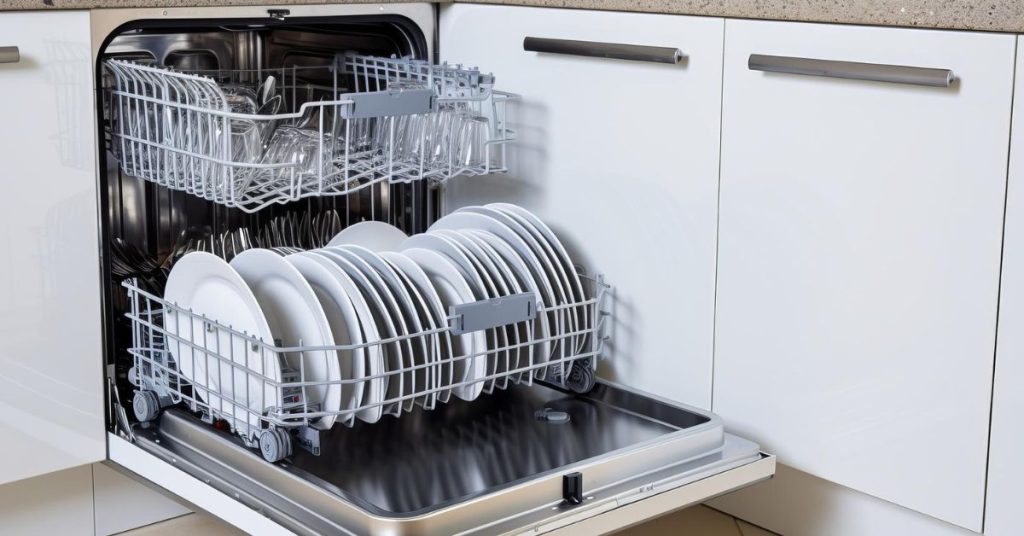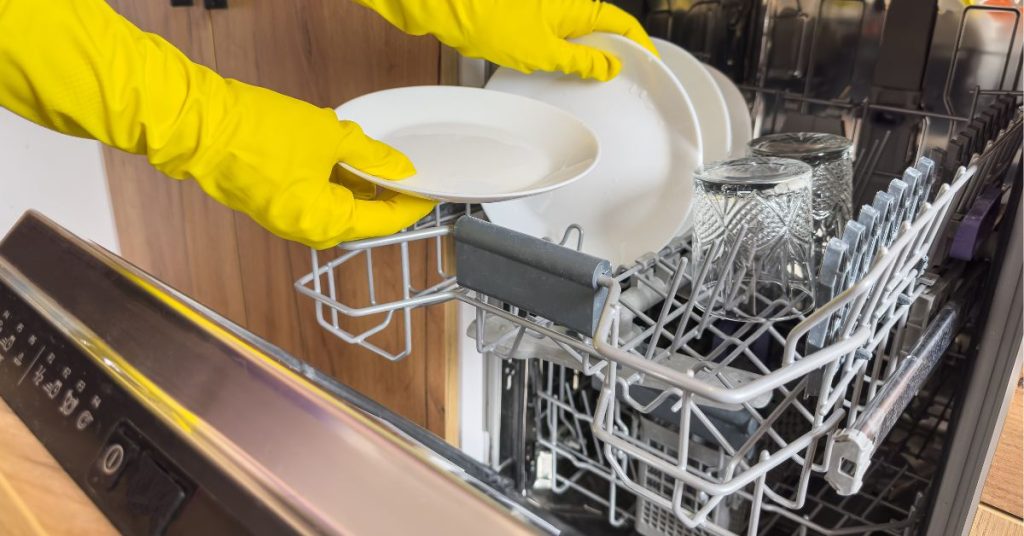Nowadays, dishwashers are among the most essential kitchen appliances. They save time, reduce the hassle of hand washing, and ensure that dishes are clean. However, a common question that arises is: How many gallons of water does a dishwasher use? Making environmentally friendly choices and managing household utility bills requires understanding your dishwasher’s water consumption.
In this guide, we’ll explore how many gallons of water a dishwasher uses and various factors that impact dishwasher water usage. If you’re considering upgrading your current model or are curious about it, this article will provide valuable information. Let’s dive in.
First Things First: Water Consumption of Dishwashers
So, really, how much water does a dishwasher use? The short answer is 6 to 10 gallons per cycle. Let us explain. Society constantly questions the impact of dishwashers on the environment. Do dishwashers save more water or consume more water? Answering the question “How much water does a dishwasher use?” depends on the model and year, but newer models are more energy efficient.
Most people still believe that the appliance requires a lot of water to operate. Perhaps the assumption has been made due to the water load needed for earlier models. However, newer dishwashers use a lot less water without sacrificing sanitation.
Industry Standards for Water Consumption in Dishwashers
In the old days, dishwashers used about 9-14 gallons of water per wash, and many people wondered, “how much does a dishwasher use?” Since 1994, dishwashers have evolved considerably, enabling more efficient models to be introduced. Currently, a conventional or average dishwasher uses 6 to 10 gallons of water per cycle, with energy usage of 0.87-1.59 kWh per load. As per industry standards, this usage of water was too high. Therefore, the standard was reduced to 5 gallons per cycle to be more water-efficient and not waste water.
Dishwasher Settings Make a Difference
Of course, another factor can complicate how much hot water a dishwasher uses. The reason is that most modern dishwashers have more than one wash setting, like three, four, or five.
Setting options might include:
- Automatic
- Normal
- Delicate
- Express
- Heavy
- Automatic
Ultimately, how much hot water each cycle setting uses will vary by dishwasher model and settings. The express and rinse cycles generally use less hot water than the other settings, whereas the heavy cycle typically uses more.
How Many Gallons of Water Does a Modern Dishwasher Use?
As dishwashers have developed with more water-saving features, many consumers wonder, “How much water does a dishwasher use?” A particular feature of these models is the Energy Star label, which certifies an appliance’s energy efficiency. A dishwasher that has an Energy Star rating uses only four gallons of water per cycle, and the compact Energy Star-rated models use only 2.7 gallons of water per cycle. The DOE calculated that such reductions in water usage could save almost 5,000 gallons a year.
How to Increase the Efficiency of Your Dishwasher
The following steps will help you save energy and improve the performance of your dishwasher, regardless of the make or model:
- Fill it up: Dishwashers use the same amount of water and electricity when they are fully loaded as when they are partially loaded. If you’re patient enough to wait until the unit is full, you can cut the number of times you run your dishwasher by 50% or more.
- Not too full: You should wait until the dishwasher is full before starting a wash cycle, but make sure there’s enough space between the dishes for the water to circulate.
- Make timely repairs: If a dishwasher breaks, it can cause extensive water damage if not repaired promptly.
- Air dry your dishes: After the wash cycle is done, open the dishwasher door to let the dishes dry on their own instead of using the heat dry cycle.
- Keep it clean: Over time, dishwasher filters and spray arms can become clogged with debris and mineral deposits. Periodic cleaning is necessary to maximize efficiency and performance.
Temperature Matters: Your Dishwasher’s Hot Water Usage
To determine how much water our dishwasher uses and how efficient it is, we also need to know how much hot water it uses. In general, newer dishwashers use water up to 140 degrees. However, like overall water usage, how much hot water your dishwasher uses depends on its age, size, and model.
Water Usage by Different Types of Dishwashers
Standard Built-In Dishwashers
The most common type is standard built-in dishwashers, which typically use four to five gallons of water per cycle. They often have multiple wash cycles and can handle larger loads. Technology advancements have improved their efficiency over the years.
Compact Dishwashers
A compact dishwasher, ideal for smaller kitchens or apartments, usually uses 3 to 4 gallons per cycle. Their smaller size and fewer parts make them more water-efficient than standard models.
High-Efficiency Dishwashers
A high-efficiency dishwasher is a champion of water conservation. Often, these models use just 3 gallons or less per cycle. With advanced features like soil sensors and energy-saving modes, they’re efficient and help you save energy and water.
How Does A Dishwasher Work?
It would be useless to compare dishwashing and hand-washing without explaining how dishwashers work. This is important to discuss, especially if you’ve never seen a dishwasher in action. Furthermore, you cannot determine how much water a dishwasher uses without first understanding how it works. How do most modern dishwashers thoroughly remove food remnants from plates and utensils?
Upon activation, a dishwasher performs the following sanitation processes:
- Water is added and heated
- Detergent is applied
- Jet-like motors are used to clean the plates and utensils
- Dirty water is washed away with a final rinse
A dishwasher keeps track of how much time it spends on each step and only needs a small amount of water at the bottom. Simply give it the detergent and the dishware to be washed, and the dishwasher will take care of the rest.
7 Dishwasher Water-Saving Tips to Maximize Your Savings
Every homeowner wants to save water and lower household expenses. Thus, it’s imperative to understand how dishwashers work and how much water they use. However, we do not want to sacrifice washing dishes in order to conserve water. Even though dishwashers already save a lot of water, you can cut it even further with the following tips:
1. Scrape But do not Pre-Rinse
You don’t need to pre-rinse your plates in the kitchen sink before putting them in the dishwasher. This defeats the purpose of a dishwasher and increases water usage. If your dishes have large leftovers of food, like bones or thick sauce, scrape them off with a utensil.
2. Minimize the Wash Cycle
You should wait until your dishwasher has a full load before running a wash cycle. As you increase the size of your dishwasher load, your energy consumption decreases as well. Having to wait for dirty dishes to accumulate throughout the day or week can get annoying. Remember how much water you saved per load! Filling the dishwasher up may help maximize the cycle, but make sure there’s enough room for water to flow through.
3. Always Opt for an Eco-friendly Setting
The dishwasher of an Energy Star-rated appliance is likely to include an eco-friendly setting. This feature allows you to use less water per load.
4. Use High-Quality Detergent
High-quality detergents are always a part of an efficient dishwasher. With hot water and good detergent, you’ll get better results, which means fewer expenses for you and less water usage.
5. Maintain a Clean Dishwasher
Keep your dishwasher clean every so often so that any leftovers don’t clog the spray arms or filters. This will allow you to make the most of your appliance’s use and product life.
6. Repair Right Away when Needed
There is nothing more inconvenient than a giant appliance that needs repair. There are times when people procrastinate getting a dishwasher repaired. Prolonging the damage could lead to bigger repairs or permanent damage altogether, which could end up costing more to fix. You don’t want to go back to washing dishes by hand, so get started right away to save money and avoid hassles.
7. Air Dry your Dishes
Usually, dishwasher cycles include a heat drying step. To save energy and water, avoid using your washing machine’s dry cycle function. The next time you use your dishwasher, open the door and let the dishes dry naturally.
Recommended Reading:
How Many Gallons of Water Does a Dishwasher Use for One Load?
In general, a dishwasher consumes between 3 and 5 gallons of water per load. Compared to older models, which used up to 10 gallons, this is a significant improvement. The amount depends on the dishwasher’s design, age, and efficiency. High-efficiency models conserve water while still providing thorough cleaning. Most ENERGY STAR dishwashers are water-efficient, often falling on the lower end of the range. Your dishwasher will use less water if you choose a water-efficient model and run full loads.
How Much Water Does a Dishwasher Use vs. Sink?
Hand-washing dishes can use a lot more water than using a dishwasher. If you leave the tap running, you might use up to 20 gallons of water for a full sink of dishes. Comparatively, modern dishwashers usually use 3 to 5 gallons per load. Even if you wash dishes in batches in the sink, you’ll use more water than a dishwasher. Unlike hand-washing, dishwashers use less energy and water to wash a full load of dishes.
How Much Water Does a Dishwasher Use on Eco Mode?
Eco mode, or energy-saving mode, reduces water and energy usage. During this mode, a dishwasher uses between 3 and 4 gallons of water per load. The eco mode often uses longer wash times and lower temperatures to conserve resources. Even though it takes a bit longer to clean your dishes, it’s great for saving water and energy. The eco mode can save you money and keep you more environmentally friendly.
How Much Water Does a Bosch Dishwasher Use?
The Bosch dishwasher is known for its advanced technology and efficiency. A Bosch dishwasher typically uses 3 to 4 gallons of water per load. Many Bosch models come with water softeners and precision wash cycles that save water. The eco-friendly designs minimize water and energy consumption while providing excellent cleaning performance. If you’re looking for a water-efficient dishwasher, Bosch is a great option.
Take a look at our guide on 7 Best Bosch Dishwashers Of 2024 to learn more.
How Much Water Does a Whirlpool Dishwasher Use?
A standard Whirlpool dishwasher uses between 4 and 5 gallons of water per cycle, which is fairly efficient. Whirlpool has dishwashers with energy-saving modes and soil sensors that help adjust water usage based on the load. These high-efficiency models are designed to save water and energy while still cleaning your dishes. You can get an even more water-efficient Whirlpool if you get the ENERGY STAR label.
Is There a Way to Save Water by Using a Dishwasher?
Yes, there are several ways to save water while using a dishwasher. To maximize water efficiency, run your dishwasher with a full load. Second, if available, use eco or energy-saving modes, as they use less energy and water. Third, check your dishwasher for leaks and clean the filters regularly. Finally, if your current dishwasher is old and uses a lot of water, upgrade to a newer, more efficient model. Follow these tips to make your dishwashing routine more eco-friendly and save water.
Conclusion
Understanding how much water your dishwasher uses can help you make more informed decisions about your kitchen appliances and their environmental impact. Modern dishwashers are designed to be much more water-efficient than older models and hand washing, making them a great choice for conserving resources. By choosing the right model and using it wisely, you can enjoy clean dishes while minimizing your water usage.







